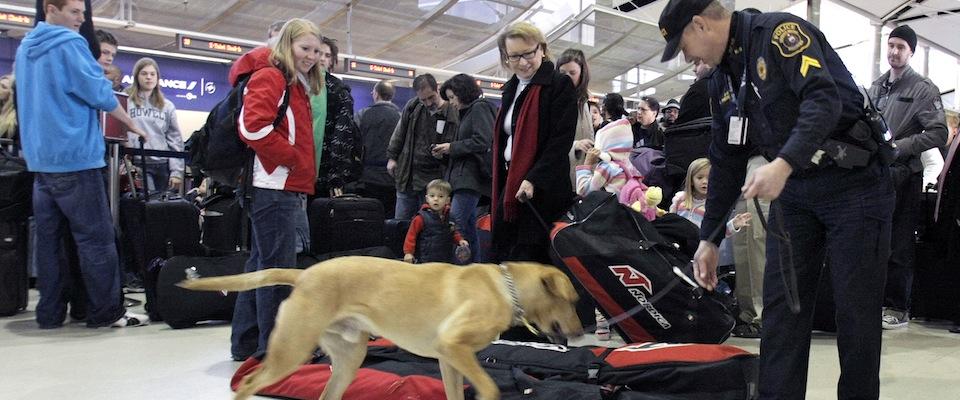Long before Lassie fished Timmy out of a well, dogs have been heroically bailing us humans out of sticky situations. In the post 9/11 era that’s never been truer, with bomb-sniffing dogs scouring our airports and cities for deadly explosives.
So it’s a shame to say that man’s best friend may be out of a job.
This week a team of researchers at UC Berkeley revealed that they have created a plasmosensor (think a really tiny laser) capable of detecting minute particles of chemicals that compose explosive material. Just how minute? According to the researchers, the sensors can locate concentrations of airborne particles as small as 0.67 parts per billion. For some perspective, that’s like actually finding a needle in a haystack.
In fact, these lasers are so sophisticated they can identify what type of explosive molecules they’re detecting—from DNT to ammonium nitrate. And because they’re made with semi-conductor technology, they potentially could be mass-produced to cover the space of an entire building—or even a city.
“Imagine tiny, tiny smoke detectors, specifically set to detect explosives,” says mechanical engineering professor Xiang Zhang, head researcher for the project. “You can have them in airports or in the city sweeping over a very large area—it gives you very large coverage.” He acknowledges that these lasers haven’t been field tested yet, but they’ve already attracted interest from law enforcement agencies and security firms.
So this raises the question: lasers or puppies? Which do we want protecting us from bombs?
In terms of efficiency, dogs are almost on the same scale of Zhang’s lasers. Equipped with somewhere between 125 million to 300 million olfactory receptors, dogs can easily detect particles at just a few parts per billion. U.S. Customs and Border Protection employs more than 800 canine teams that search for everything from narcotics and explosives to smuggled currency and fruit. And as we all know, dogs can track individual people by their odor for miles.
Even when sniffer dogs generate false alerts, they’re not always off the mark. Andy Kaufman, an officer in the San Francisco Police Department’s bomb detection unit, says that when a dog alerts its handlers to a package or a bag that is seemingly empty, it may be responding to trace chemicals. “If we go open it and there’s nothing inside, that doesn’t mean there’s no chemical consistent with a bomb-making material that was in the bag before,” Kaufman says.
Unlike Zhang’s lasers, dogs can be employed for a wide range of activities aside from bomb detection. Kaufman notes that SFPD’s K-9’s are trained for sniffing out explosives as well as narcotics—plus they’re often used to track suspects or flush them out of buildings deemed too dangerous for humans to enter.
But even professional pooches have their drawbacks. For starters, they’re entirely reliant on their handlers for guidance. That means they can be easily manipulated—occasionally for illegal activity. Last year, a retired police officer filed a lawsuit against the Nevada Highway patrol, claiming that K-9 units were deliberately trained by their handlers to give false alerts to justify illegal searches and seizures of vehicles.
This is a relatively rare problem. A bigger issue with dogs is their price tag. K-9 recruits typically require two to three months of rigorous training at specialized facilities. The price of a trained sniffer dog varies, but Kaufman says SFPD pays $10,000 for each of the canines they get from Adlerhost International, and some agencies pay as much as $15,000 per animal.
Another drawback: Dogs have a short career span. Kaufman says most sniffer dogs are between the ages of 2 and 4 when they begin work, and they’re retired around age 9 or 10, assuming injuries don’t force them into premature retirement. The SFPD, like many other agencies, purchases Belgian Malinois—a smaller cousin of the German Shepherd with stronger hips that support a longer work life. Still, they suffer inevitable wear and tear, not to mention job stress.
And for some, there is a moral principle. Their handlers may place sniffer-dogs in dangerous situations, for which the animals pay the price. So, too, do handlers who not only work the dogs but typically take them home at the end of each day, transforming them into family pets.
So what’s more preferable? For now it may not matter. Zhang said it will be at least several years before he can imagine manufacturing his lasers on a commercial scale.
Kaufman said he personally welcomes any new technology that will help his unit, but he doesn’t see lasers replacing dogs. Instead, he envisions them supplementing the traditional police work he’s already doing with his canine companion, Argos.
“It’s going to have to take time to see what happens,” Kaufman said. “Sometimes you’ve got to use some of the old school and new school methods to get the job done.”



















